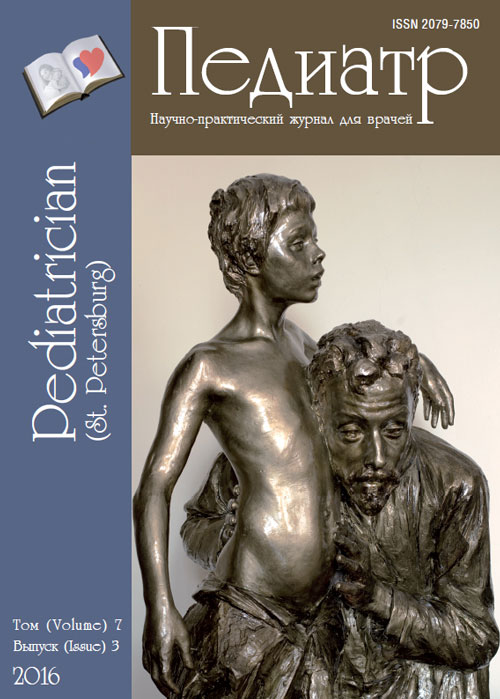Neuroimaging of full term newborn´s brain with hypoxic-ischemic encephalopathy
- Authors: Melashenko T.V1, Pozdnyakov A.V1, Alexandrov T.A1
-
Affiliations:
- St Petersburg State Pediatric Medical University
- Issue: Vol 7, No 3 (2016)
- Pages: 157-161
- Section: Articles
- URL: https://journals.eco-vector.com/pediatr/article/view/5738
- DOI: https://doi.org/10.17816/PED73157-161
- ID: 5738
Cite item
Abstract
Keywords
Full Text
About the authors
Tatiana V Melashenko
St Petersburg State Pediatric Medical University
Author for correspondence.
Email: melashenkotat@mail.ru
MD, PhD. Anesthesiology and Intensive Care Neonatal Perinatal Center Russian Federation
Alexander V Pozdnyakov
St Petersburg State Pediatric Medical University
Email: pozdnyakovalex@ya.ru
MD, PhD, Dr Med Sci, Professor, Head. Department of Medical Biophysics, Radiology Department Russian Federation
Timofey A Alexandrov
St Petersburg State Pediatric Medical University
Email: ale-tim@list.ru
Department of Medical Biophysics, Radiology Department Russian Federation
References
- Мелашенко Т.В., Гузева В.В. Особенности транзиторной биоэлектрической активности головного мозга у недоношенных детей с перинатальным гипоксически-ишемическим поражением центральной нервной системы // Педиатр. — 2014. — Т. 5. — № 1. — С. 32–36. [Melashenko TV, Guzeva VV. Particular transit patterns EEG in premature babies with hypoxia-ischemic encephalopathy. Pediatr (St Petersburg). 2014;5(1):32-36. (In Russ).]
- Aeby A, Liu Y, Tiege X De, et al. Maturation of Thalamic Rediations between 34 and 41 Weeks Gestation: A Combined Voxel — Based Study and Probabilitic tractography with Diffusion Tensor Imaging. AJNR. 2009;30:1780-1786. doi: 10.3174/ajnr.A1660.
- Ball C, Boardman James P, Daniel Rueckert, et al. The Effect of Preterm Birth on Thalamic and Cortical Development. Cerebral Cortex. 2012;22(5):1016-1024. doi: 10.1093/cercor/bhr176.
- Barkovich AJ, Westmark K, Partridge C, et al. Perinatal asphyxia: MR findings in the first ten days. JNR. 1995;16:427-438.
- Cabaj AG, Bekiesin’ska-Figatowska M., Madzic J. MRI patterns of hypoxic — ischemic brain injury in preterm and full term infants — classical and less common MR findings. Pol J Radiol. 2012;77(3):71-76. doi: 10.12659/PJR.883379.
- Cowan F, Rutherford M, Groenendaal F, et al. Origin and timing of brain lesions in term infants with neonatal encephalopathy. Lancet. 2003;361:736-742. doi: 10.1016/S0140-6736(03)12658-X.
- Dergans M, Osredkar D. Hypoxic-ischemic brain injury in the neonatal period — current concepts, novel diagnostic approaches and neuroprotective strategies. Zdrav Vestn. 2008;77(II):51-8.
- Himmelmann K, Hagberg G, Wiklund LM, et al. Dyskinetic cerebral palsy: a population-based study of children born between 1991 and 1998. Dev Med Child Neurol. 2007;49:246-251. doi: 10.1111/j.1469-8749.2007.00246.x.
- Kurinczuk JJ, White-Koning M, Badawi N. Epidemiology of neonatal encephalopathy and hypoxic-ischaemic encephalopathy. Early Hum Dev. 2010;86:329-338. doi: 10.1016/j.earlhumdev.2010.05.010.
- Linda S. de Vries, Groenendaal F. Patterns of neonatal hypoxic-ischaemic brain injury. Neuroradiology. 2010;52:555-566.
- Linda S de Vrries, Jongmans MJ. Long-term outcome after neonatal hypoxic — ischaemic encephalopathy. Arch Dis Child Fetal Neonatal Ed. 2010;95: F220-F224. doi: 10.1007/s00234-010-0674-9.
- Nikas I, Dermentzoglou V, Theotanopoulou M, Theodoropoulos V. Parasagittal Lesions and Ulegyria in Hypoxic-Ischemic Encephalopathy: Neuroimaging Findings and Review of the Pathogenesis. Child Neurol. 2008;23(1):51-58. doi: 10.1177/0883073807308694.
- Nucitora PGP, Verma R, Lee S-K, Methem ER. Diffusion — Tensor MR Imaging and Tractography: Exploring Brain Microstructure and Connectivity. Radiology. 2007;245:367-384. doi: 10.1148/radiol.2452060445.
- Rosenbloom L. Dyskinetic cerebral palsy and birth asphyxia. Dev Med Child Neurol. 1994;36(4):285-289. doi: 10.1111/j.1469-8749.1994.tb11848.x.
- Sarnat HB, Sarnat MS. Neonatal encephalopathy following fetal distress: a clinical and electroencephalographic study. Archives of Neurology. 1976;33:696-705. doi: 10.1001/archneur.1976.
- Ten Vadim S, Tang Haijing, Bradley-Moore M, et al. Late Measures of Brain Injury After Neonatal Hypoxia-Ischemia in Mice. Stroke. 2004;35:2183-2188. doi: 10.1161/01.STR.0000137768.25203.df.
- Twomey E, Twomey A, Ryan S, et al. MR imaging of term infants with hypoxic — ischaemic encephalopathy as a predictor of neurodevelopmental outcome and late MRI appearance. Pediatr Radiol. 2010;40:1526-1535. doi: 10.1007/s00247-010-1692-9.
- Volpe JJ. Brain injury in premature infants: a complex amalgam of destructive and developmental disturbances. Lancet Neurol. 2009;8:110-124. doi: 10.1016/S1474-4422(08)70294-1.
- Yeatman JD, MB-Shachar, Bammer R, Feldman HM. Using Diffusion Tensor Imaging and Fiber Tracing to Characterize Diffuse perinatal White Matter Injury: A case Report. J of Child Neurology. 2009;24:794-800. doi: 10.1177/0883073808331080.
Supplementary files









